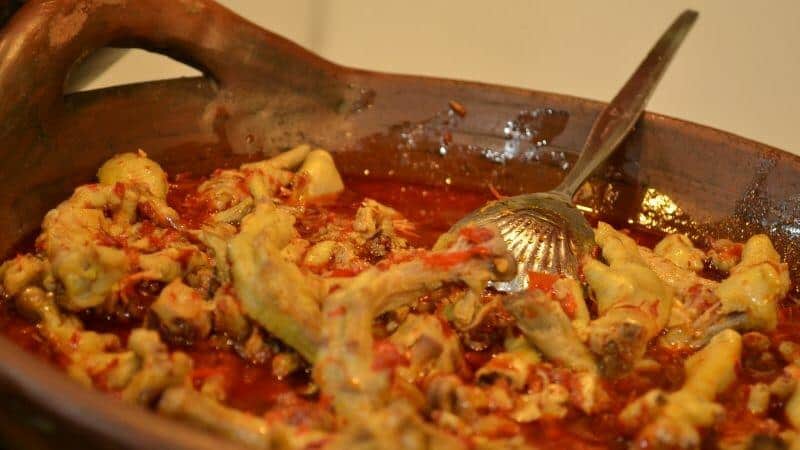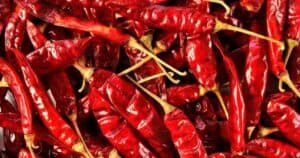Spicy foods are polarizing; you either love them or hate them. Losing its heat can make a dish more or less desirable, depending on palates and preferences. Many spicy dishes seem to lose heat over time; does food actually become milder the longer you keep it?
Spicy food doesn’t get less spicy over time. However, our perception of heat alters depending on food temperature and our own natural tolerance.
This article examines how and why cool food loses its heat and discusses the best ways to develop tolerance to spicy foods. Additionally, I’ll look at ways to reduce heat in dishes that kick too hard.
The Food Cools
Your spicy meal inevitably cools over time. Perhaps you’re a slow eater, or maybe you have leftovers that need to be stored in the refrigerator. Whatever the impetus, cooling your food lessens the kick the
- Cold food stimulates fewer taste receptors. Cold foods are bland because they excite fewer taste buds and olfactory sensors than hot foods. The
spice level in your cold dish is the same as if it were warm; however, your tongue doesn’t perceive the heat. - The heat is trapped in fat. Sauteing spices and peppers in oil and fat releases their heat. The flavors and spices transfer to the fat, separating from the food when cooled. Reheating the food re-releases the flavors, but the cold dish tastes milder than initially prepared.
- Condensation. Grinding spices releases their heat. The spiciness is contained in essential oils that condense when refrigerated.
- Mellowing. The flavors of many spicy foods mellow over time. Mellowing is not so much a decrease in heat as a more thorough blending of flavors and ingredients.
Eating spicy food hot maximizes the impact of the heat. Two different types of heat –
You Develop a Tolerance
The
The TRPV1 Receptor
The TRPV1 receptor is the sensory neuron that reacts to heat. Capsaicin activates the TRPV1 receptors and sends a message to your brain: this is hot.
Different people have different numbers of TRPV1 receptors. People with fewer TRPV1 receptors have less sensitivity to heat, and those with more TRPV1 receptors feel a more significant burn.
However, even with fewer TRPV1 receptors, continued exposure to spicy food dulls the impact of the heat.
Developing a Tolerance to Capsaicin
Capsaicin hits the nerve endings in your tongue, and they send a message to your brain to burn and feel the heat. Using some simple techniques, you can develop a tolerance to capsaicin’s burning effects.
- Gradually adding spicy foods to your diet. Incrementally adding hot food allows you to develop a tolerance.
- Incrementally increasing the heat. Gradually increasing the heat level in your food allows you to build up a more robust tolerance and makes the previous heat levels more palatable.
- Eating slowly. Every time you eat hot food, it stimulates the nerve endings anew, triggering a heat reaction. Eating too quickly prevents your tongue and throat from having adequate time to recover. Slower ingestion allows sufficient time for recovery, building up your tolerance to
spice . - Control your own heat levels. This allows you to increase the spicy levels at a pace and in amounts that work best for you.
- Keep milk nearby. Capsaicin isn’t water-soluble, so the beverage has no impact on the burning sensation in your mouth. On the other hand, milk adheres to the capsaicin and levels out the heat.
Reducing Heat Levels
Cooling foods is neither a guaranteed nor a quick way to reduce the
Add Some Acid
Capsaicin is an alkaline oil which means that certain cooking acids neutralize the impact of its pH levels. Stir in the following ingredients to cool too-spicy foods:
- Lemon juice
- Lime juice
- Vinegar
- Wine
- Tomato
- Tomato sauce
- Pineapple
Try adding chopped tomatoes or pineapples in quarter cup installments until your dish is mild enough to ingest comfortably.
Give whatever ingredient you add fifteen to thirty minutes to simmer and take effect. If the dish remains too spicy, add more to the taste.
Add Vegetable Oil
Capsaicin is oil-soluble, meaning the compound will dissolve and thin in the substance. Adding a complimentary oil, one teaspoon at a time, reduces the heat of a spicy dish without compromising the texture and integrity of the plate.
Nut butters contain oils that break down the heat while adding the rich flavor of the legumes.
Consider using any of the following to lessen the spiciness in your meal:
- Grapeseed oil
- Olive oil
- Coconut oil
- Peanut butter
- Cashew butter
- Almond butter
- Tahini
Exercise restraint when adding these ingredients, as they can alter the consistency of your dish.
Add Some Dairy
Dairy products are rich in casein, a protein that binds itself to capsaicin. Once the casein surrounds and attaches itself to the spicy molecules, it disperses them, cooling the dish. Dairy can be mixed into the dish directly or served as a dipping sauce. Sprinkling cheese on top of your meal also lessens the
Any of the following products makes your hot food milder:
- Butter
- Ghee
- Cow’s milk
- Plain yogurt
- Cheese (especially soft cheeses)
- Sour cream
Stick to full-fat dairy options for the best results, and keep in mind that incorporating any of these ingredients into your dish will alter the consistency, making it creamier. Add whatever dairy product you choose gradually; use small increments, tasting frequently, until you achieve your desired flavor.
Add Some Sweetness
Sugars absorb the spicy oils that add heat to your food. Add sugar or honey by the teaspoon, stirring well and allowing the flavors ample opportunity to meld. Bear in mind that sugar or honey makes your dish sweeter in addition to reducing heat levels, so you’ll want to add the ingredient judiciously.
Thin the Heat
Simply adding more non-spicy ingredients reduces the heat level of a dish. Use foundational elements, such as:
- Sauce
- Stock
- Vegetables
- Meat
Don’t worry if you’ve used all of your dish’s primary ingredients. Simply add neutral-flavored components that will dilute the impact of the
- Carrots
- Celery
- Onions
- Grated potatoes
- Squash
The addition of any ingredient alters the consistency of your dish, making a meal thinner or creamier, depending on what you stir in. Additionally, serving a neutral and mild side dish reduces spiciness without compromising the integrity and texture of the hot food.
Conclusion
Though time makes spicy food seem milder, the heat levels don’t actually change over time. Additionally, various factors impact capsaicin’s effect on your tastebuds and cooled foods don’t stimulate as many receptors and sensors as hot foods.
Fats capture spicy oils and leach them from the dish as it sits and cools, and flavors blend and meld, making them taste milder and more mellow. Your tolerance to spicy food is adaptable and can be built up, making hot dishes seem milder to you. If, however, you want your spicy food milder, there are many simple ways to alter the meal to make it cooler.
Sources
- Crimson Coward: How To Increase & Enjoy Your Spicy Food Tolerance in 5 Ways!
- Go SzeChuan House: Readers ask: Why Is Leftover Thai Food Hotter? – Szechuan House-Lutherville
- Healthy Eating: How to Neutralize Spicy Foods
- Forbes: The Science Of Leftovers: Why They Taste SO Good
- Brain Facts: Taste and Smell
- NCBI Bookshelf: TRPV1 Receptors and Signal Transduction – TRP Ion Channel Function in Sensory Transduction and Cellular Signaling Cascades





